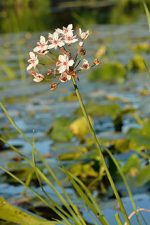 Also called grass rush, this aquatic perennial is native to in Eurasia and Africa where it grows in the margins of still and slowly moving water. It is a member of the Butomaceae, a small family of only one or two species, and is not a true rush. The plants have a rhizomatous root system and grow to about 5′ tall. The linear leaves arise in two rows along the rhizome and are up to 3′ long, pointed, and twisted. From mid to late summer terminal umbels of 20 to 50 light-pink to rose-colored scented flowers appear. Each flower is about 1″ across and has 3 petals and 3 petaloid, slightly smaller sepals. The fruit is a many-seeded capsule that ripens from late summer to early fall.
Also called grass rush, this aquatic perennial is native to in Eurasia and Africa where it grows in the margins of still and slowly moving water. It is a member of the Butomaceae, a small family of only one or two species, and is not a true rush. The plants have a rhizomatous root system and grow to about 5′ tall. The linear leaves arise in two rows along the rhizome and are up to 3′ long, pointed, and twisted. From mid to late summer terminal umbels of 20 to 50 light-pink to rose-colored scented flowers appear. Each flower is about 1″ across and has 3 petals and 3 petaloid, slightly smaller sepals. The fruit is a many-seeded capsule that ripens from late summer to early fall.
Considerable uncertainty exists for the identification of the words in two passages of the Bible that are variously translated as sedge-bush, flag, rush, reed/reed-grass, meadow-grass, marsh, meadow, grass, and papyrus. The identification of the plant is also uncertain but flowering rush (Butomus umbellatus) is is good possibility because it meets the requirements of the text; that it is edible and lives in marshy river banks. Yellow nutsedge ( Cyperus esculentus) is an alternative suggestion and is edible but grows in sandy soil and fields.
Genesis 41:2 (NIV) The Pharaoh recounts his dream for Joseph’s interpretation.
“when out of the river there came up seven cows, sleek and fat, and they grazed among the reeds.”
Job 8:11 (NIV) Bildad uses the example of papyrus to teach Job cause and effect.
“Can papyrus grow tall where there is no marsh? Can reeds thrive without water?”
Flowering rush likes full sun and wet soil (such as in marshy river banks) in USDA Hardiness Zones 4-8. It is susceptible to Pestalotiopsis guepinii, Steyaert, Virgaria nigra, Hansfordia ovalispora, Fusarium oxysporum, and Phoma sp. Propagation is by fresh seed and fragmentation of the root system. The plants are very attractive in a water garden and have become invasive in the US but are endangered in Israel where they are native.
The genus name, Butomos, comes from the Greek words bous meaning ox and tomos meaning cutting, and refer to the sharp edeges of the leaves. The specific epithet, umbellatus, is from the Latin umbra word meaning shield from the sun and was later applied to the item we call an umbrella. Later, the diminutive of the word,umbellata, was applied to the the umbrella which has many spokes originating in one place giving rise to the use of the word for inflorescences resembling an umbrella.